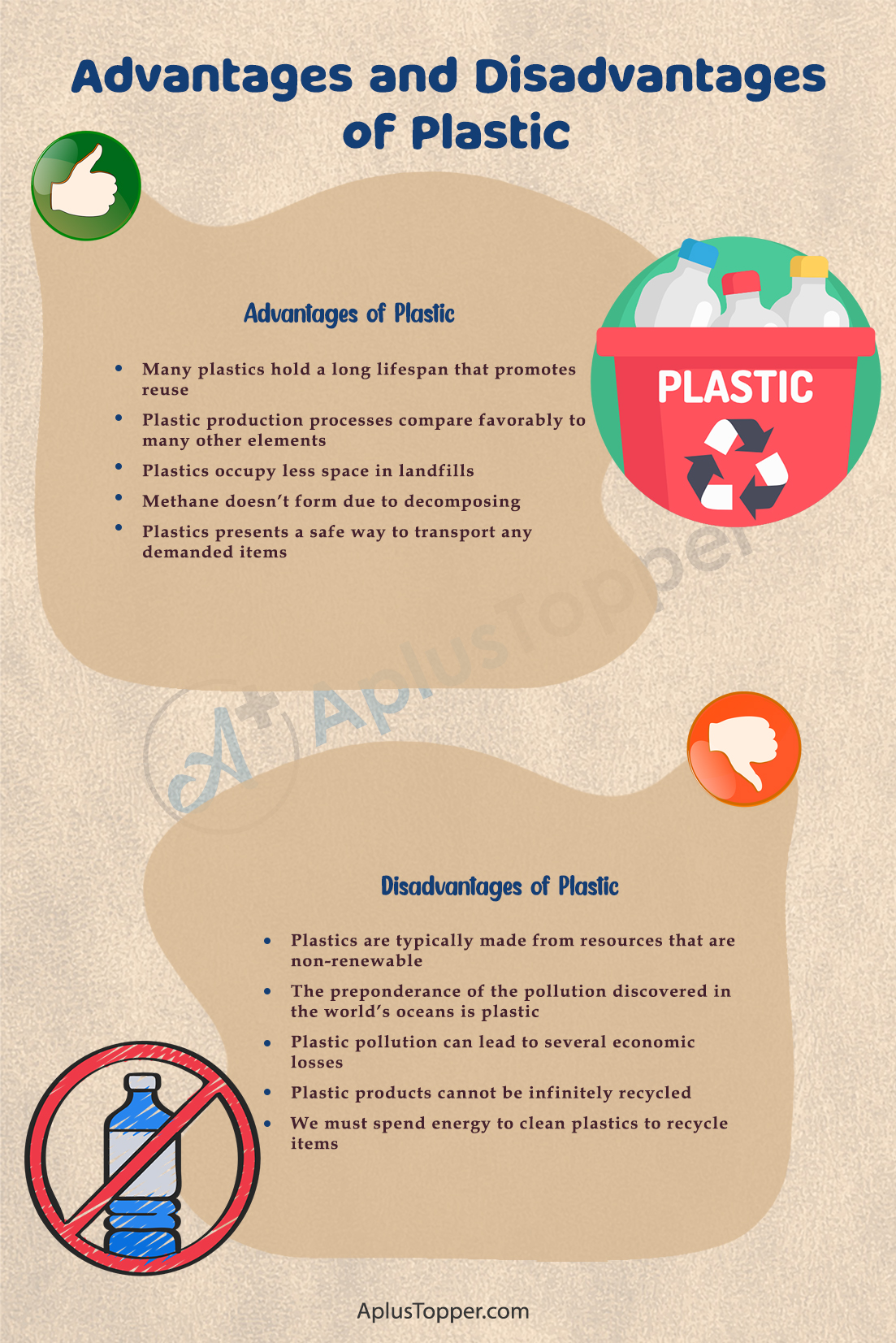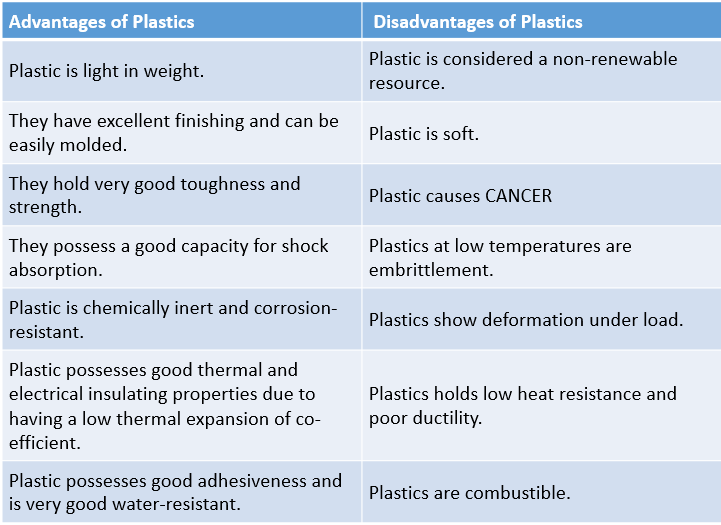Advantages and Disadvantages of Plastic: Because of the research conducted by John Wesley Hyatt in 1869, the first plastic product appeared. This original celluloid gained instant praise as the savior of tortoises and elephants. In order to protect the natural world from the human’s destructive demand to consume.
Students can also find more Advantages and Disadvantages articles on events, persons, sports, technology, and many more.
What is Plastic? Advantages and Disadvantages of Plastic
Plastic may be the most polarising substance of recent times. It presents a series of incredible benefits that help people every day, but the product can also be one of the most harmful materials on our planet. It was a word that originally meant the product was easily shaped and pliable. It is only modern definitions that presently have the term concern to a variety of polymers.
The plastics’ advantages and disadvantages required constant review as new polymers went into the development process in order to avoid detrimental environmental impacts of plastics.
Let’s discuss some of them:
- Advantages of Plastics
- Disadvantages of Plastics
- Comparison Table for Advantages and Disadvantages of Plastics
- FAQs on Pros and Cons of Plastics
Here are a few of the advantages and disadvantages of plastics:

Advantages of Plastics
- Many plastics hold a long lifespan that promotes reuse: Plastics don’t require to be treated as disposable or be a single-use product. Many forms of this substance have a long lifespan that is greater than or equal to what other materials rendered. A maintained and well-made PVC pipe has the capability of rendering service for up to a century. Plastics used in construction have an average lifespan of 35 years.
- Plastic production processes compare favorably to many other elements: The manufacturing process of plastics can be energy-intensive with fossil fuels, but in comparison to other materials, it is still a resource that is more environmentally friendly. Recycling methods can modify the comparison at times. It is still a distinct advantage that plastics can contribute when consistent reuse occurs.
- Plastics occupy less space in landfills: Even though it can take a notable amount of time for plastic materials to crumble down in a landfill, but when compared to other items, the amount of space that plastics take up in these waste disposal areas is minimal. Paper products comprise seven times more volume.
- Methane doesn’t form due to decomposing: Organic materials, when commencing decomposing, release greenhouse gases. The focus of this method is often on carbon dioxide, but the methane that gets released is extremely toxic. Methane is up to 20 times more potent as a reflecting atmospheric product when compared to CO2. Plastics don’t release this gas when it begins breaking down, which means it is simpler to calculate the total lifecycle impact of the outcome.
- Plastics presents a safe way to transport any demanded items: Since plastic keeps the product safe, so use of plastics for bottles that contain water, and other beverages is better. People utilise the material to affordably and quickly get water to helpless populations all over the world.
Disadvantages of Plastics
- Plastics are typically made from resources that are non-renewable: Although the first materials of plastic came from fibers that were plant-based, most of the items that are produced now have fossil fuels as their foundation. It’s normally petroleum, but one can also utilise natural gas to generate this product. About 4% of these fuels persist directly into the plastics industry to produce new products. When a person looks at the number of resources utilised during the refinement process and the anticipated rise in demand, within the next decade, the fossil fuel cost of plastics could reach 20%.
- The preponderance of the pollution discovered in the world’s oceans is plastic: Up to 80% of all marine detritus comprises plastic. This problem comes from marine and land sources, often accumulating in large areas of open water where tides come together. This issue affects us to find waste on land, on beaches and even in sources of fresh water. Some of the items that get scattered most often are stirrers, bottles, lids, food wrappers and plastic straws. At the cost of 5perkilogram,itcomesforremovingplasticpollutionfromoceansurfacewater,butitisonly0.30 for the item’s reused. That’s why the attempt to clean up marine regions is being led by agencies that are non-profitable.
- Plastic pollution can lead to several economic losses: Plastic packaging pollution by itself generates an economic loss of approximately $80 billion annually to the global economy. It makes up approximately 50% of all waste from this industry, and practically every other industry practices the item in some way. Construction and building plastics represent 16% of plastic use, while textiles are accountable for about 15%. Since it isn’t beneficial to recycle many of the items, more of it tends to progress into waste streams alternately of reuse. For plastic recycling, the global average is about 14%. by recycling approximately 60% of plastics and its items, India is one of the world’s leaders, while the United States, by recycling only 9%, becomes close to last in the developed world.
- Plastic products cannot be infinitely recycled: Metals, because of the properties of the material, can be numerous times recycled into a diversity of different products. Plastics don’t bestow that opportunity. People can only recover or reuse it a specific number of times before it loses its integrity and quality. That means people are more likely to down-cycle this product, stash it in a landfill or incinerate it. Some plastic items and products can’t be recycled at all, furthering the influence of this disadvantage. Over 93 billion products of plastic don’t perceive touched each year, which means they enter into our waste streams.
- We must spend energy to clean plastics to recycle items: Plastics that produce cross-contamination with diverse types formulate unusable products. Before recyclers can transform the things into new pieces, they also require to have the items cleaned.
Some products comprise different plastic types in the same item (i.e. a bottle and a lid), producing even more challenges to accomplish. It’s a problem that makes recycling inefficient at best for some communities – and sometimes impracticable.

Comparison Table for Advantages and Disadvantages of Plastics
| Advantages of plastics | Disadvantages of plastics |
| Plastic is light in weight. | Plastic is considered a non-renewable resource. |
| They have excellent finishing and can be easily molded. | Plastic is soft. |
| They hold very good toughness and strength. | Plastic causes CANCER |
| They possess a good capacity for shock absorption. | Plastics at low temperatures are embrittlement. |
| Plastic is chemically inert and corrosion-resistant. | Plastics show deformation under load. |
| Plastic possesses good thermal and electrical insulating properties due to having a low thermal expansion of co-efficient. | Plastics holds low heat resistance and poor ductility. |
| Plastic possesses good adhesiveness and is very good water-resistant. | Plastics are combustible. |
| Plastic is cheap to produce. | When plastics are burnt, it produces toxic fumes |
| Plastic does not decompose and holds a recycling process. | The recycling process is very costly. |
| Plastic bottles can be restored and reused over again and again. |

FAQs on Pros and Cons of Plastics
Question 1.
What are the pros and cons of using plastic?
Answer:
The benefits of plastics are durable material, low cost, water-resistant, lower energy. And cons are: produces toxic fumes, low temperatures are embrittlement, causes CANCER, etc.
Question 2.
What are the advantages of plastic?
Answer:
The properties of plastic are chemically inert and resistant to rust. They have strong electric and thermal insulating properties and have a low coefficient, thermal expansion.
Question 3.
What are the negative effects of plastic?
Answer:
Toxic chemicals drain out of plastic and are existing in practically everybody’s tissue and blood. Exposure to them is related to birth defects, tumors, disturbance of the endocrine system, compromised immunity, and other disorders.
